Average sizes and life expectancy for this breed:
The Bengal is a medium to large domestic cat well-known for its luxurious, highly contrasted coat of bright spots and unique marbling. The breeds’ popularity has soared in recent years due to its wild appearance and active, fun-loving personality. Bengals are the only domestic cat breed with rosettes similar to the markings on leopards, jaguars, and ocelots, and are now considered to be one of the most popular short-haired breeds in the world.
Bengal cats are known to be curious, confident, and devoted companions. As an incredibly athletic breed, Bengals love to keep active and enjoy being involved in everyday family life. They maintain this kitten-like energy and attitude until their senior years, so you need to ensure you have the space and commitment to cater to their needs throughout their lives. These affectionate cats love to engage in play with their owners, learn new tricks, and can quickly pick up the rules of the house if they are taught using positive reinforcement methods. Bengals are known to be incredibly vocal cats and will happily meow or chirrup when they want something!
This breed is not considered to be your typical lap cat. Whilst they will curl up with you on occasion, you are more likely to see them chasing, climbing, investigating, and playing. Their cuddle time is usually when they sleep. Bengal cats also love to climb and view the world from high vantage points. So, you will often see them on bookshelves, high desks, and atop your doors.
As highly intelligent cats, Bengals can be trained to perform numerous tricks such as playing fetch, walking on a harness and lead, and learning to sit on command.
Bengal cats are loyal, loving, and can quickly become an integral part of any family, even with children and other animals. However, a few of the Bengal cat's wild instincts have been retained, including their love of water. For this reason, Bengal cat owners are encouraged to keep their toilet seats closed but don’t be surprised if you then find your Bengal trying to drink from a tap! You will probably also find that your Bengal enjoys watching you brush your teeth, and may even join you in the shower!
These playful cats must not be left at home unaccompanied for long periods. They do well with another cat or a small dog to keep them company, as long as they have been introduced properly.
See available kittens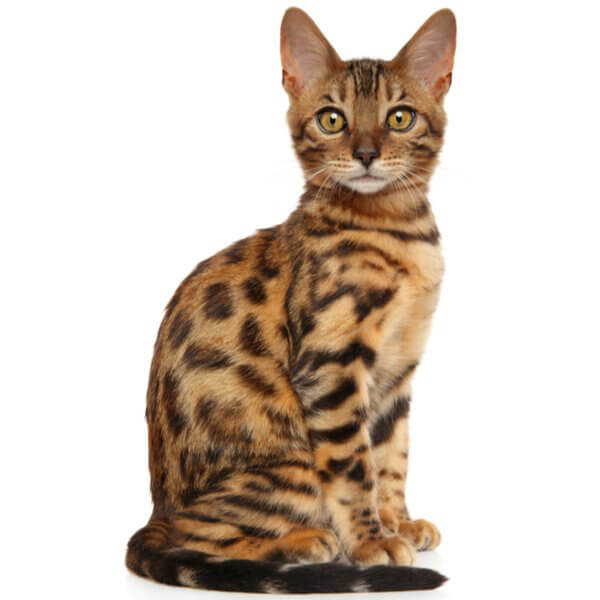




The Bengal was bred in the United States during the 1970s and introduced in the United Kingdom in the early 1990s. In 1997, the cat breed was finally recognized by the GCCF but only awarded its full Championship status in 2005. Bengal cats were initially developed by crossing Asian Leopard Cats with domestic tabbies. This produced the first generation of hybrid females (F1). Other cat breeds were then introduced into the mix including the Egyptian Mau, Abyssinian and Burmese cats to widen the breed's gene pool.
Jean S. Mill, the founder of the Bengal breed, wanted to produce a cat breed that mirrored a miniature leopard but had an affectionate and sweet temperament. To date, Bengal cats are considered to be the only truly successful mating between a wild cat and a domestic cat. Through meticulous, careful, and conscientious breeding, Jean Mill managed to develop a cat breed that did not have the "wild" traits seen in the Asian Leopard Cat.
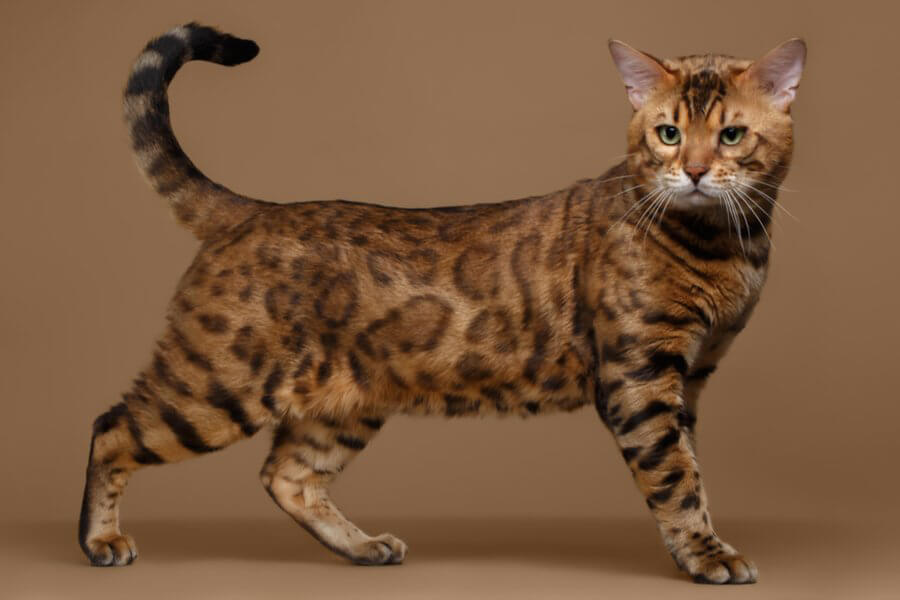

Bengals are handsome, eye-catching medium to large cats. They have gorgeous marbled or spotted coats, as well as exquisite, musculature and a well-balanced, athletic build. Bengal cats boast an alert and enthusiastic expression that adds to their impressive and endearing appearance. These stunning cats also have the friendly and affectionate personalities to match, making them a great choice for families.
Bengal cats have full, wedge-shaped heads with well-rounded contours. Their heads are slightly longer than they are wide, which showcases their beautiful high cheekbones. Their heads tend to be relatively small compared to the rest of the body. Bengals have broad muzzles with a sturdy, rounded chin and very prominent whisker pads that add to their "wild" appearance.
A Bengal cat's ears are small to medium in size with rounded tips, set well apart on the head. Their eyes are round or slightly oval-shaped. Bengal cats boast a short to medium coat that is very dense, soft, and smooth to touch. Bengal kittens tend to have slightly longer coats than mature, adult Bengal cats.
The most common colour combination found on Bengals is the brown/black tabby variety. Their gorgeous coats can be anything from grey to vivid shades of bronze, copper, gold, or mahogany, with the marbling or spots ranging from brown to intense black. This cat breed can also come in white (referred to by breeders as ‘Snow Bengals’). The original variation of this coat colour was thought to be the result of the albino gene found in Siamese cats. However, it has continued to be purposely bred by adding Burmese cat genes to the mix. The coat appears light tan, ivory, or cream with marbling or spots of light brown to dark chocolate. Snow Bengals tend to have blue eyes, other varieties can have yellow, green, or gold eyes.
Silver Bengal cats have grey to almost white backgrounds with dark grey to black patterns. The silver colouring is not actually a colour at all, but a lack of colour caused by an inhibitory gene. They may have almost white undersides and facial markings to show the tabby pattern, which is distinctive in a Bengal cat's colouring.
Bengal cats are considered to be an ideal choice for families. They usually form strong bonds with one person in particular but are generally very friendly and affectionate with everyone. They are also known to be very intelligent and remain playful even into their golden years. This makes them fun to be with, but they can be challenging at times. Bengal cats are talkative, friendly, and confident. They love to play games, and you'll be amazed at how quickly this breed can learn new tricks!
Compared to other cat breeds, Bengal's love being in and around water. They love playing with a running tap or watching the water in a toilet as it's flushed.
Bengal cats are very active but are always happy to curl up near their owner on a sofa when tired.
Many Bengal cat owners opt to keep their Bengal cats as indoor pets. Fortunately, they adapt well to confined environments but keep in mind that they are high-energy cats. They must be kept busy to be truly happy and content. This means buying lots of good quality, interactive toys. Bengal cats also like to be up high, so you should provide indoor platforms for them to look down on the world from.
Bengal cats are the happiest when they are near their person. They do well in large apartments and houses as long as they are provided with plenty of places to climb and play. An excellent investment would be a cat tree to keep your Bengal cat entertained. If you need to leave the house for long periods, it is a good idea to have a second cat to keep them busy.
This cat breed also has a high prey drive. They enjoy watching squirrels, birds, and other small animals through your home's windows. It is a great idea to install a carpeted perch by your windows to give them a comfortable viewing station.
Lastly, make sure that you keep your Bengal cats entertained as they can develop unconventional habits such as turning light switches on and off, plucking CDS from your DVD players, or fishing seals out of your kitchen or bathroom drains.


The key to making a Bengal cat happy is to encourage mental stimulation. It is best to start them young by introducing them to other people, especially children, and other pets. You can even start putting them on a leash and harness for some time outdoors. Because Bengal cats are so intelligent, you should offer them plenty of opportunities to learn new things as this will keep their minds and bodies stimulated.
Bengal cats are fond of climbing; the higher, the better. They are highly intelligent and love the attention that comes with being clicker trained. Challenge their brains and keep them attentive! You can do this by teaching your Bengal cat tricks and games using interactive or puzzle toys.
Bengal coats come in many colours and patterns, including seal mink tabby, brown tabby, seal silver lynx point, and black silver tabby. The coat can be spotted throughout, formed into horizontal patterns, or marbled. They may also have horizontal stripes arranged randomly on a lighter background. Some Bengals have a coat that is defined as ‘glittered’, where the fur shines in the light as if it were sprinkled with gold dust.
It is essential to brush them once a week, check their ears regularly, and clean them when needed. If there's too much wax build-up in the ears, it can lead to a painful and severe infection that can be hard to treat.
As for their nutrition, Bengal cats require proper nutrients and protein that comes from poultry, meat, and fish. A high-quality diet is best for these cats. It is also important to note that they are prone to becoming overweight after spaying or neutering. Make sure you are aware of the quality and quantity of food you give your cats. Most cat breeders will advise against free feeding adult cats because of the obesity risk.
Bengal cats do well on a raw diet, which is available at most pet stores. Also, make sure to provide your cat with fresh and clean water every day.
As with any other cat, you must ensure that you keep your Bengals litter boxes clean. They are very particular about their bathroom hygiene and may not use a litter tray if it is dirty or smelly. If left unclean, they may choose to do their business elsewhere in the house, which can be a problem.


A Bengal cat's average life expectancy is between 12 and 16+ years when cared for properly and provided with an appropriate, high-quality diet that is suited to their age.
Like many cat breeds, Bengals are known to be generally healthy. However, it is essential to acquire a kitten from a registered and reputable cat breeder who runs DNA and other health tests on their cats. That way, you’ll have peace of mind that they will live a long and healthy life.
Some health conditions that affect the breed, which every good cat breeder would test for before breeding takes place to make sure the condition is not passed on to the kittens:
The active and social Bengal is an ideal choice for families with children and cat-friendly dogs. They can play fetch like any retriever, learn tricks quickly, and love the attention they receive from children who treat them with care and respect.
They are very sociable by nature, adore the company of children, and spend hours playing interactive games with them. However, it is still best for younger children and Bengal cats to be supervised by an adult to prevent any mishaps.
Bengal cats are also known to be good around dogs, especially if they have been well socialized from an early age. It is highly recommended that you supervise any interactions between a Bengal cat and smaller animals or pets, as Bengals have a strong hunting instinct so may view them as ‘fair game’.


We can connect you with Breeders that are specialized in this particular breed.
See available kittens
Ethiopia
Size : Medium
Coat : Short
Registration : GCCF, TICA, CFA, FIFe
Vocality : Low
Hypoallergenic : No
Grooming : Once a Week
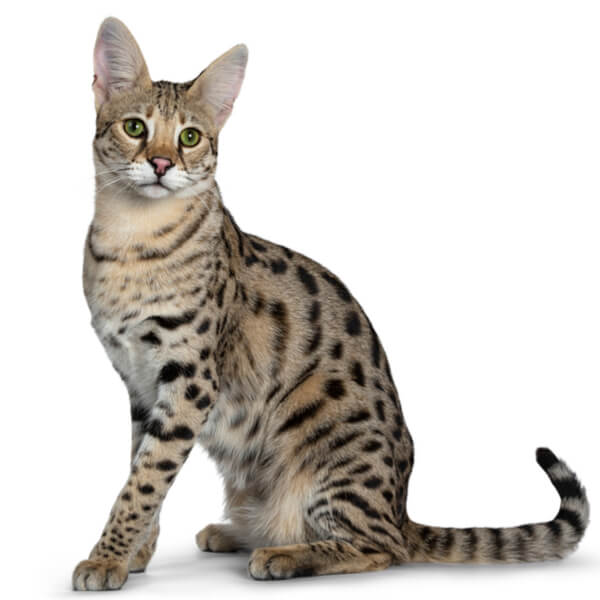
United States of America
Size : Large
Coat : Short
Registration : TICA
Vocality : Low
Hypoallergenic : No
Grooming : Once a Week

Egypt
Size : Medium
Coat : Short
Registration : GCCF, TICA, CFA, FIFe
Vocality : Low
Hypoallergenic : No
Grooming : Once a Week

United States of America
Size : Medium
Coat : Short
Registration : GCCF, TICA, CFA, FIFe
Vocality : Medium
Hypoallergenic : Yes
Grooming : Once a Week


Need some advice?
Whether you're a first time pet owner, an experienced pet owner, a new or long-time breeder, or just curious about pets, we've got you covered!
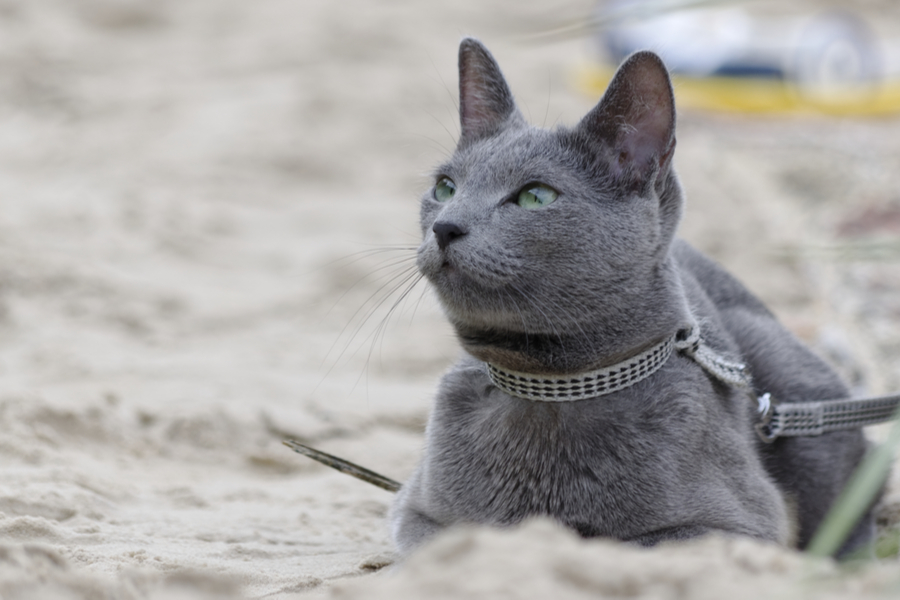
January 17, 2024
What Is The Personality Of Russian Blue Cats?
Russian Blue cats are most known for their distinctive shimmery blue-silver coat and piercing green eyes. However, this breed’s calm and gentle temperament is what makes them shine the most in the feline world.
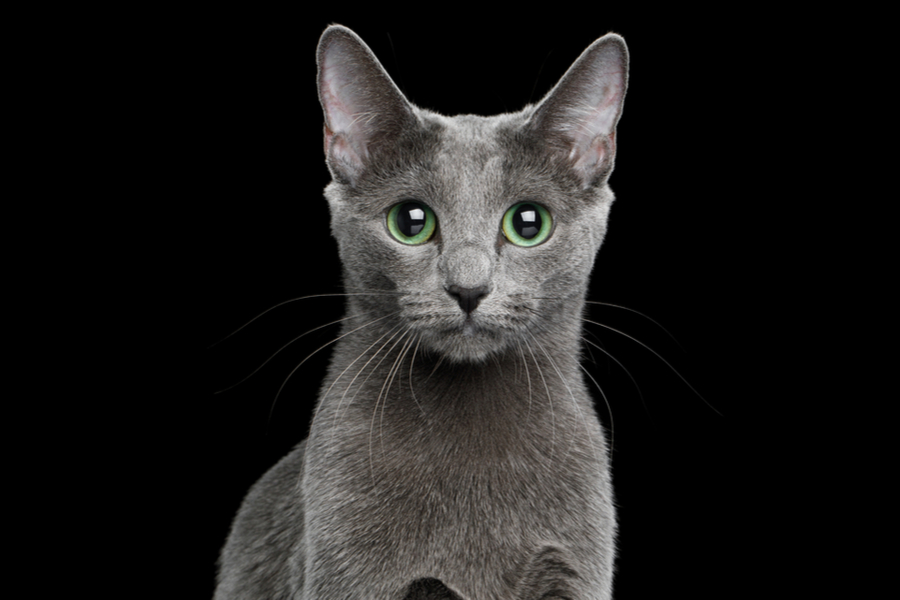
January 17, 2024
10 Facts About Russian Blue Cat Breed
Russian Blues are one of the most aesthetically stunning cat breeds, with a gorgeous plush silvery coat and vibrant green eyes. However, it’s not only their appearance that is beautiful; their nature is too.
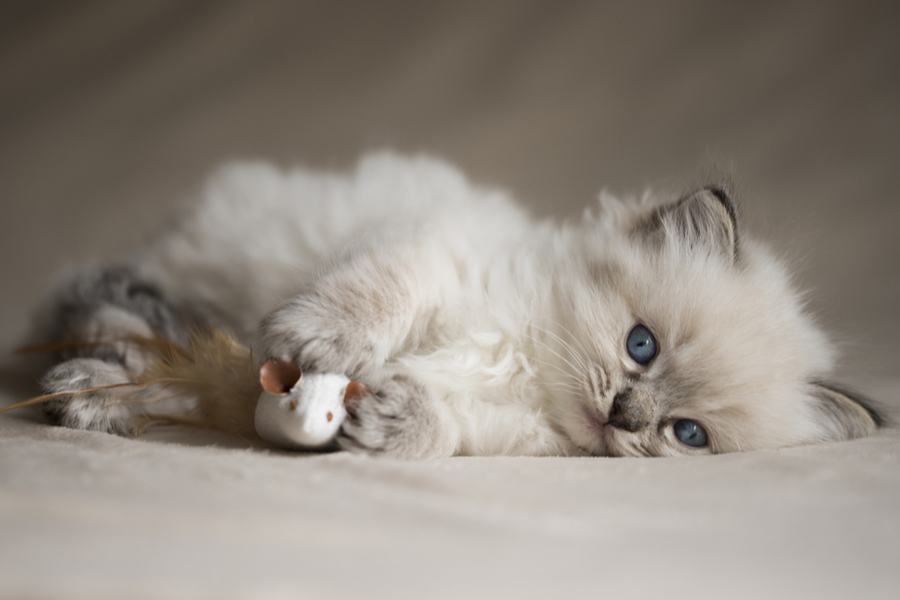
January 17, 2024
How To Choose The Right Cat Breed for You
Cats can make the most fantastic animal companions; they are adorable, friendly, and loving. However, not all felines are created equal. There are many different breeds, of which each has its unique personality traits.
Need some help?
Contact us to speak to our friendly advisor, who will gladly help you find your dream pet!



We are registered in England and Wales under registration number 12568840,
and our registered office is at 58-60 Kensington Church Street, W8 4DB London, England.
© 2023 The Pedigree Paws